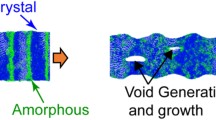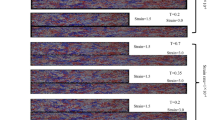Abstract
Polyurea is an elastic co-polymer which possesses a very complex nanometer-scale microstructure consisting of (high glass-transition temperature, T g) hydrogen-bonded discrete hard domains dispersed within a (low T g) contiguous soft matrix. A number of experimental investigations reported in the open literature clearly established that (a) polyurea has an unusually high capacity for shock mitigation and (b) this ability of polyurea is related to its segmental dynamics (the same process which is responsible for the rubbery-to-glassy transition). Due to the fact that the segmental dynamics in question involves a large number of atoms with coordinated motion and, hence, is associated with nanosecond to microsecond characteristic times, it cannot be generally analyzed using all-atom molecular dynamics techniques. To overcome this problem, mesoscale coarse-grain simulation methods are employed in this study. Within the all-atomic simulation methods, the material is modeled as a collection of constituent atom-size particles. Within the mesoscale methods, on the other hand, this atomistic description of the material is replaced with a collection of coarser particles/beads which account for the collective degrees of freedom of the constituent atoms. Consequently, before the mesoscale methods could be employed to polyurea, all-atom molecular analyses had to be used to determine the basic properties (i.e., mass and radius) of the beads and to parameterize the mesoscale bonding and non-bonding forcefield functions. The mesoscale analyses were then used to (a) obtain critical information regarding the material microstructure and its evolution (from an initially fully blended homogeneous state) and (b) the segmental dynamics in the microsegregated state of the material.









Similar content being viewed by others
References
Ryan AJ (1989) Polymer 3(1):707
Amini MR, Isaacs JB, Nemat-Nasser S (2008). In: Proceedings of the 2006 SEM annual conference and exposition on experimental and applied mechanics, St. Louis, MO, p 3
Amini MR, Isaacs JB, Nemat-Nasser S (2010) Int J Impact Eng 37:82
Amirkhizi AV, Isaacs J, McGee J, Nemat-Nasser S (2006) Philos Mag 86(36):5847
Amini MR, Amorkhizi AV, Nemat-Nasser S (2010) Int J Impact Eng 37:90
Balden VH, Nurick GN (2005) Int J Impact Eng 32:14
Grujicic M, Bell WC, Pandurangan B, He T (2010) J Mater Des 31:4050
Grujicic M, Pandurangan B, He T, Cheeseman BA, Yen C-F, Randow CL (2010) Mater Sci Eng A 527(29–30):7741
Roland CM, Cassini R (2007) Polymer 4(8):5747
Grujicic M, Pandurangan B, He T, Hunt J, Tarter J, Dillon G (2011) J Mater Des Appl 225(3):182
Bogoslovov RB, Roland CM, Gamache RM (2007) Appl Phys Lett 90:221910
Sun H (1998) J Phys Chem B 10(2):7338
Sun H, Ren P, Fried JR (1998) Comput Theor Polym Sci 8(1/2):229
Grujicic M, Pandurangan B, King AE, Runt J, Tarter J, Dillon G (2011) J Mater Sci 46(6):1767. doi:10.1007/s10853-010-4998-y
Grujicic M, Pandurangan B, Bell WC, Cheeseman BA, Yen C-F, Randow CL (2011) Mater Sci Eng A 528(10–11):3799
Grujicic M, Bell WC, Pandurangan B, Cheeseman BA, Fountzoulas C, Patel P, Templeton DW, Bishnoi KD (2011) J Mater Des Appl 225(4):298–315
http://www.accelrys.com/mstudio/msmodeling/visualiser.html. Accessed 31 Aug 2011
Grujicic M, Sun YP, Koudela KL (2007) Appl Surf Sci 25(3):3009
http://www.accelrys.com/mstudio/msmodeling/discover.html. Accessed 31 Aug 2011
http://www.accelrys.com/mstudio/msmodeling/amorphouscell.html. Accessed 31 Aug 2011
Marrink SJ, de Vries AH, Mark AE (2004) J Phys Chem B 108:750
http://www.accelrys.com/mstudio/msmodeling/mesodyn.html. Accessed 31 Aug 2011
http://www.accelrys.com/mstudio/msmodeling/mesocite.html. Accessed 31 Aug 2011
Runt J (2011) Work in progress, Pennsylvania State University
Acknowledgements
The material presented in this article is based on work supported by the Office of Naval Research (ONR) research contract entitled “Elastomeric Polymer-By-Design to Protect the Warfighter Against Traumatic Brain Injury by Diverting the Blast Induced Shock Waves from the Head,” Contract Number 4036-CU-ONR-1125 as funded through the Pennsylvania State University, the Army Research Office (ARO) research contract entitled “Multi-length Scale Material Model Development for Armor-grade Composites,” Contract Number W911NF-09-1-0513, and the Army Research Laboratory (ARL) research contract entitled “Computational Analysis and Modeling of Various Phenomena Accompanying Detonation Explosives Shallow-Buried in Soil” Contract Number W911NF-06-2-0042. The authors are indebted to Dr. Roshdy Barsoum of ONR for his continuing support and interest in this study. The authors also want to thank professors J. Runt, J. Tarter, G. Settles, G. Dillon, and M. Hargether for stimulating discussions and friendship.
Author information
Authors and Affiliations
Corresponding author
Rights and permissions
About this article
Cite this article
Grujicic, M., Pandurangan, B. Mesoscale analysis of segmental dynamics in microphase-segregated polyurea. J Mater Sci 47, 3876–3889 (2012). https://doi.org/10.1007/s10853-011-6243-8
Received:
Accepted:
Published:
Issue Date:
DOI: https://doi.org/10.1007/s10853-011-6243-8




